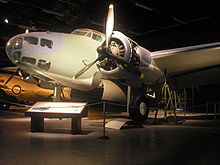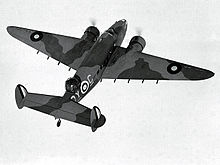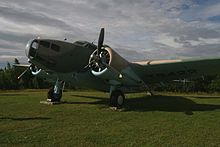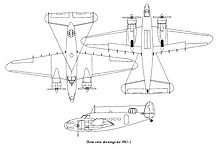Lockheed Hudson
| Lockheed A-28/29 Hudson | |
|---|---|
 Lockheed A-29 of the United States Army Air Forces |
|
| Type: | |
| Design country: | |
| Manufacturer: | |
| First flight: |
December 10, 1938 |
| Commissioning: |
1939 |
| Production time: |
1938 to 1942 |
| Number of pieces: |
2940 |
The Lockheed Hudson (US designation: A-28 , A-29 , PBO-1 , AT-18 ) was a twin-engine light bomber and coastal reconnaissance aircraft of the Second World War from American production.
history
Based on the Lockheed 14 Super Electra , Lockheed developed a light bomber that was ordered by the British Royal Air Force for Coastal Command in June 1938 . The first machine, whose series was designated as the Hudson Mk. I, flew on December 10, 1938. In the summer of 1939, the machines were assigned to the Coastal Command. In the following years almost 2000 machines of the Mk. I, Mk. II and Mk. III series were delivered to the Royal Air Force.
The aircraft was mainly used by the Coastal Command, then by the US Navy , the USAAF and the Air Forces of Canada , Australia , New Zealand , Brazil , Ireland , China , the Netherlands , Portugal and South Africa .
A Royal Air Force Hudson was the first Allied aircraft to take off from the British Isles during World War II and shot down a German aircraft (a Dornier Do 18 over Jutland on October 8, 1939 ). When the Allies were shot down earlier, the aircraft had taken off in France or from an aircraft carrier . Hudsons were also involved in the attack on the Altmark and in the hijacking of the German submarine U 570 . A British Hudson also succeeded in sinking a German submarine using missiles for the first time in May 1943 .
In 1942 the first machines, now designated as A-28 , were delivered to the USAAF . By 1942, 82 A-28 and 418 A-29 were produced. There were also 300 AT-18 trainers and 20 machines that were flown by the US Navy as PBO-1s . A Navy PBO-1 was also the first US aircraft to sink a German submarine ( U 656 off the coast of Newfoundland on March 1, 1942).
variants
- Hudson i
- First main production version for the Royal Air Force (RAF). 351s were built for the RAF, another 50 for the Royal Australian Air Force (RAAF)
- Hudson ii
- Identical to the Hudson I, but with non-adjustable propellers; 20 machines were made for the RAF and 50 for the RAAF.
- Hudson III
- Main production version for the RAF with retractable lower body combat stand; 428 were built.
- Hudson IIIA
- Variants of the A-29 and A-29A supplied to the UK under the loan and lease agreement; 800 copies delivered.
- Hudson IV
- Largely identical to the Hudson II, but without a lower hull combat stand; 30 of these machines were built. In addition, all remaining Mk I and II of the RAAF were converted to Hudson IV.
- Hudson IVA
- A-28 delivered to the Australian Air Force; 52 were delivered to the RAAF.
- Hudson V
- Modified Mk III with the 1,200 hp Wright R 1830 S3C4 G Wasp engines; 409 manufactured.
- Hudson VI
- A-29A supplied to the UK under the loan and lease agreement; 450 copies delivered.
- A-28
- Version for the United States Armed Forces. Powered by 1050 horsepower Wright R-1830-45 engines; 52 delivered to Australia as Hudson IVA.
- A-28A
- A-28 that can be used as a troop transport; 450 copies were delivered as Hudson VI to the RAF, 27 more to the Brazilian Air Force.
- A-29
- A-28 with the 1200 hp Wright-R-1830-S3C4-G-Wasp engines; 416 were built for the RAF, 153 went to the USAAF as RA-29 and 20 were used as PBO-1 by the US Navy.
- A-29A
- A-29 troop transport with adjustable propellers; 384 went to the RAF as Hudson IIIA, some remained with the USAAF as RA-29A.
- A-29B
- 24 recovered A-29s that were converted into photo reconnaissance aircraft.
- AT-18
- Training version for training gunmen, with R-1820-87 engines; 217 manufactured.
- AT-18A
- Navigation trainer without a back fight stand.
- C-63
- Temporary name for the A-29A.
- C-111
- Civil model for Australia.
- PBO-1
- Former RAF Hudson IIIA serving on the US Navy's VP-82.
production
Almost all of the A-28 / A-29 and 995 aircraft of the A-29 were delivered to the RAF. In total, the RAF received 2345 Hudson.
Approval of the Lockheed Hudson by the RAF / USAAF:
| version | 1939 | 1940 | 1941 | 1942 | 1943 | TOTAL |
|---|---|---|---|---|---|---|
| Hudson Mk. I | 280 | 170 | 450 | |||
| Hudson Mk. II | 20th | 20th | ||||
| Hudson Mk. III | 120 | 308 | 428 | |||
| Hudson Mk. IV | 30th | 30th | ||||
| Hudson Mk. V | 409 | 409 | ||||
| A-28 | 52 | 52 | ||||
| A-28A | 450 | 450 | ||||
| A-29 | 331 | 286 | 617 | |||
| A-29A | 100 | 83 | 183 | |||
| AT-18 | 217 | 217 | ||||
| AT-18A | 33 | 50 | 83 | |||
| TOTAL | 280 | 340 | 1100 | 869 | 350 | 2939 |
Military users

-
 Australia
Australia
- Royal Australian Air Force
-
 Brazil
Brazil
- Força Aérea Brasileira
-
 China
China
- National China Air Force
-
 Vichy France
Vichy France
- marine
-
 Ireland
Ireland
-
 Israel
Israel
-
 Canada
Canada
- Royal Canadian Air Force
-
 Netherlands
Netherlands
- Koninklijke Luchtmacht
-
 New Zealand
New Zealand
- Royal New Zealand Air Force
-
 Portugal
Portugal
- Força Aérea Portuguesa
-
 South African Union
South African Union
- South African Air Force
-
 United Kingdom
United Kingdom
- Royal Air Force
-
 United States
United States
- United States Army Air Forces
- United States Navy
Technical specifications
| Parameter | A-29 data |
|---|---|
| Type | light bomber, scout |
| Manufacturer | Lockheed Aircraft Corporation |
| crew | 5 |
| length | 13.52 m |
| span | 19.95 m |
| height | 3.62 m |
| Empty mass | 5825 kg |
| Max. Takeoff mass | 9320 kg |
| drive | two radial engines Wright R-1820 -87 Cyclone with 1,200 HP each (approx. 880 kW) |
| Top speed | 405 km / h |
| Range | 4480 km |
| Service ceiling | 8100 m |
| Armament | five or seven 7,62 mm machine guns , bombs up to 635 kg |
Web links
Individual evidence
- ^ Peter J. Marson: The Lockheed Twins. Air-Britain (Historians), Tonbridge 2001, ISBN 0-85130-284-X , p. 7.
- ↑ KJ Meekcombs: The British Air Commission and Lend-Lease. Trowbridge 2009, pp. 64, 96 ff.
- ↑ Statistical Digest of the USAF 1946. pp. 100 ff .; KJ Meekcombs: The British Air Commission and Lend-Lease. Trowbridge 2009, p. 96 ff.




